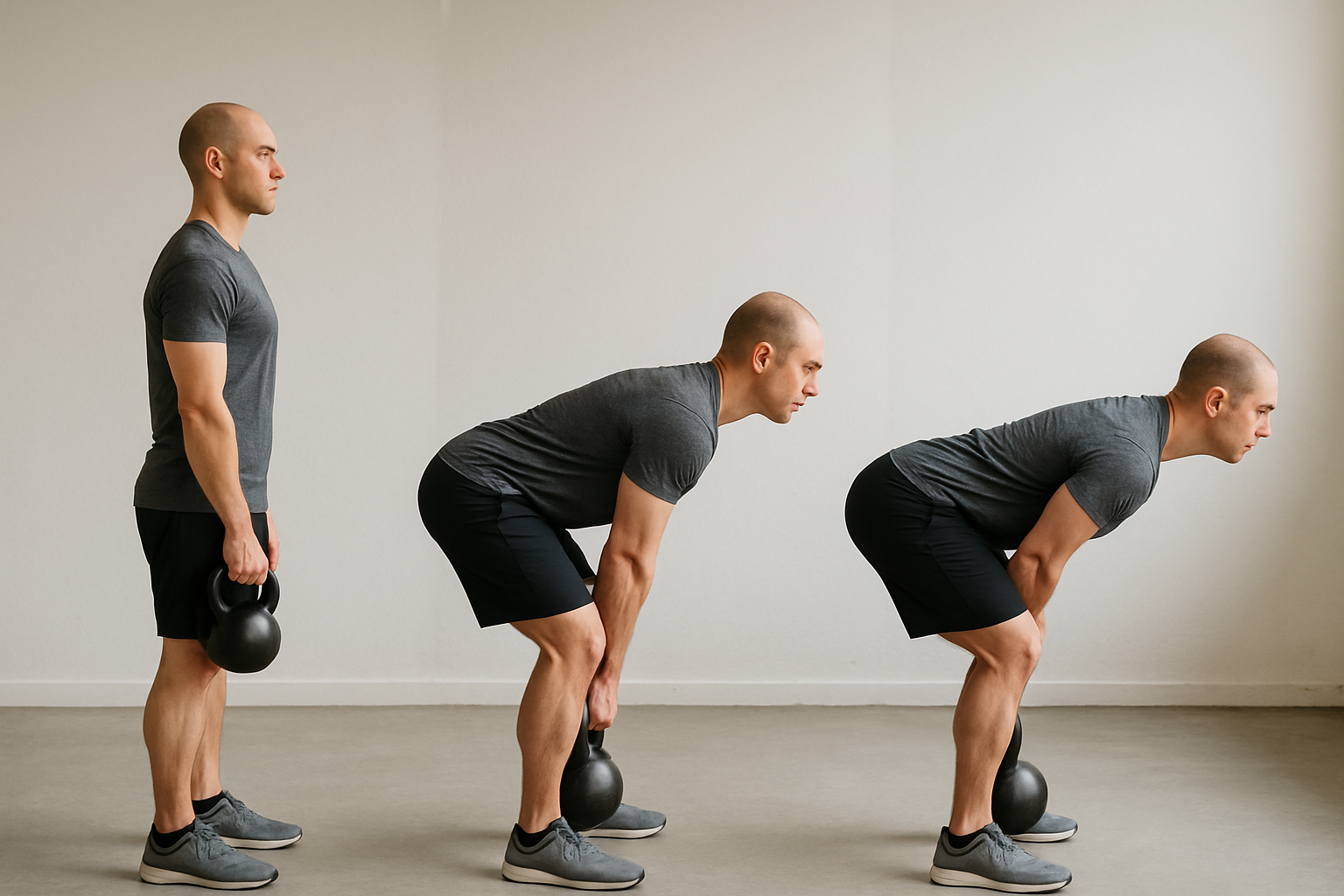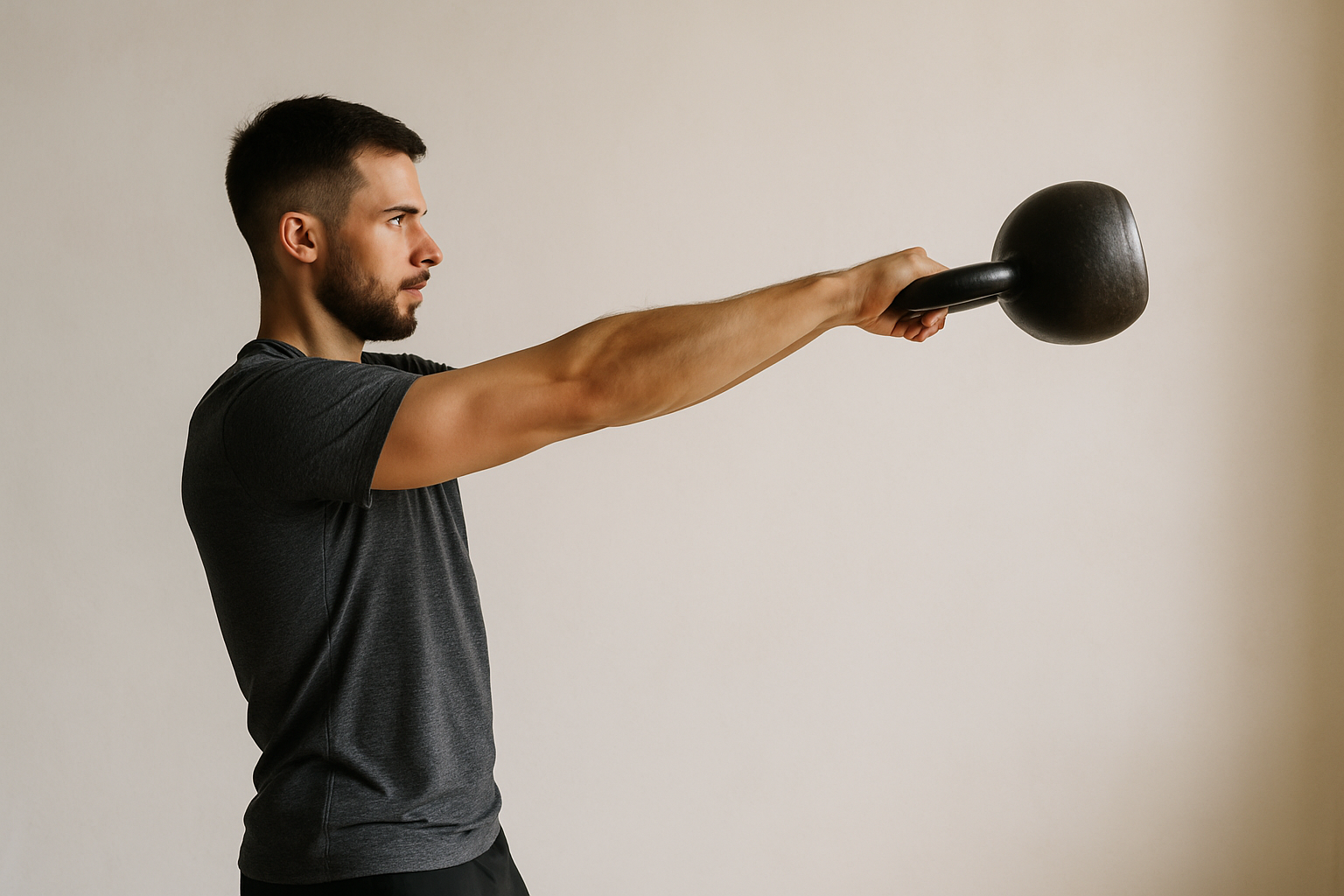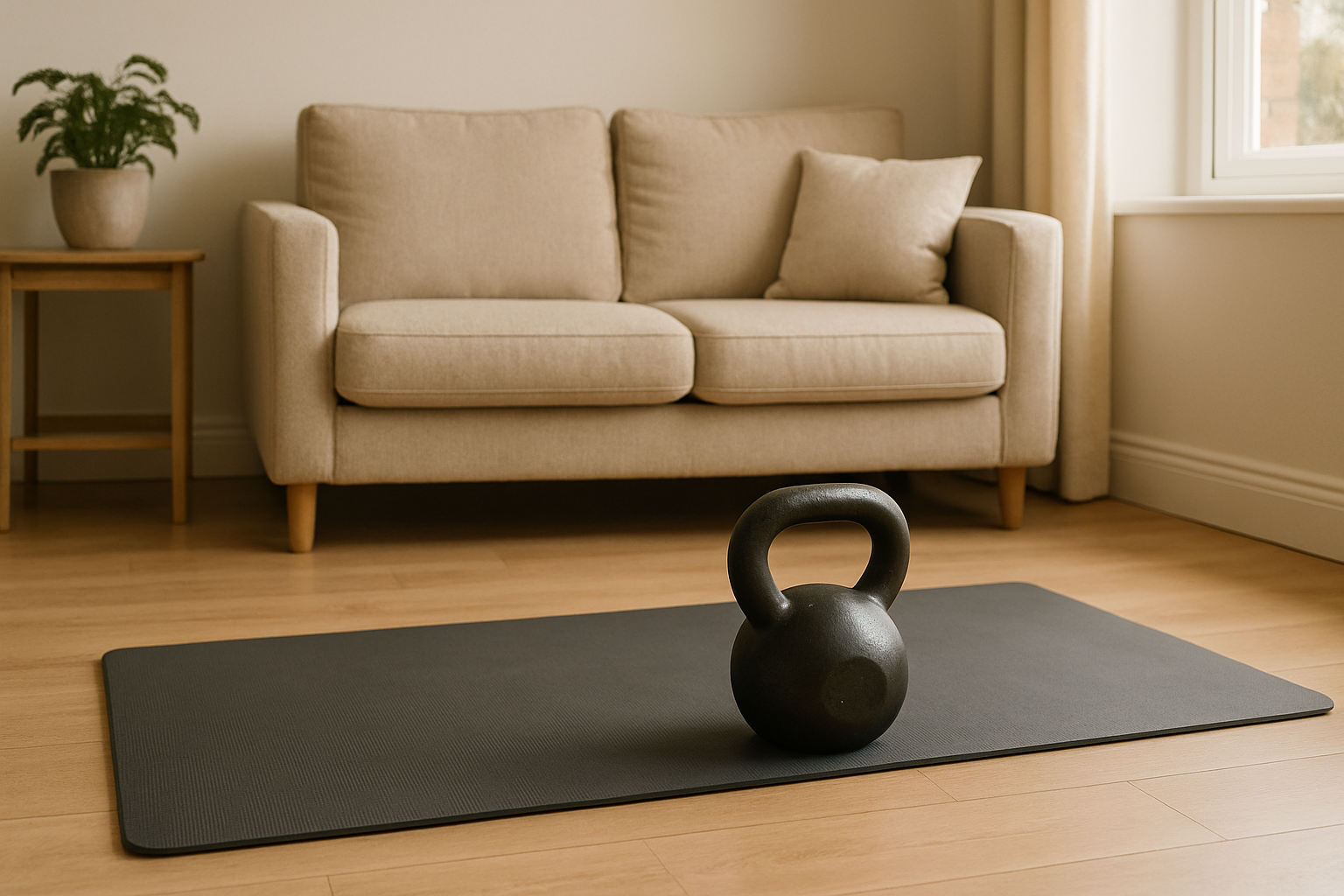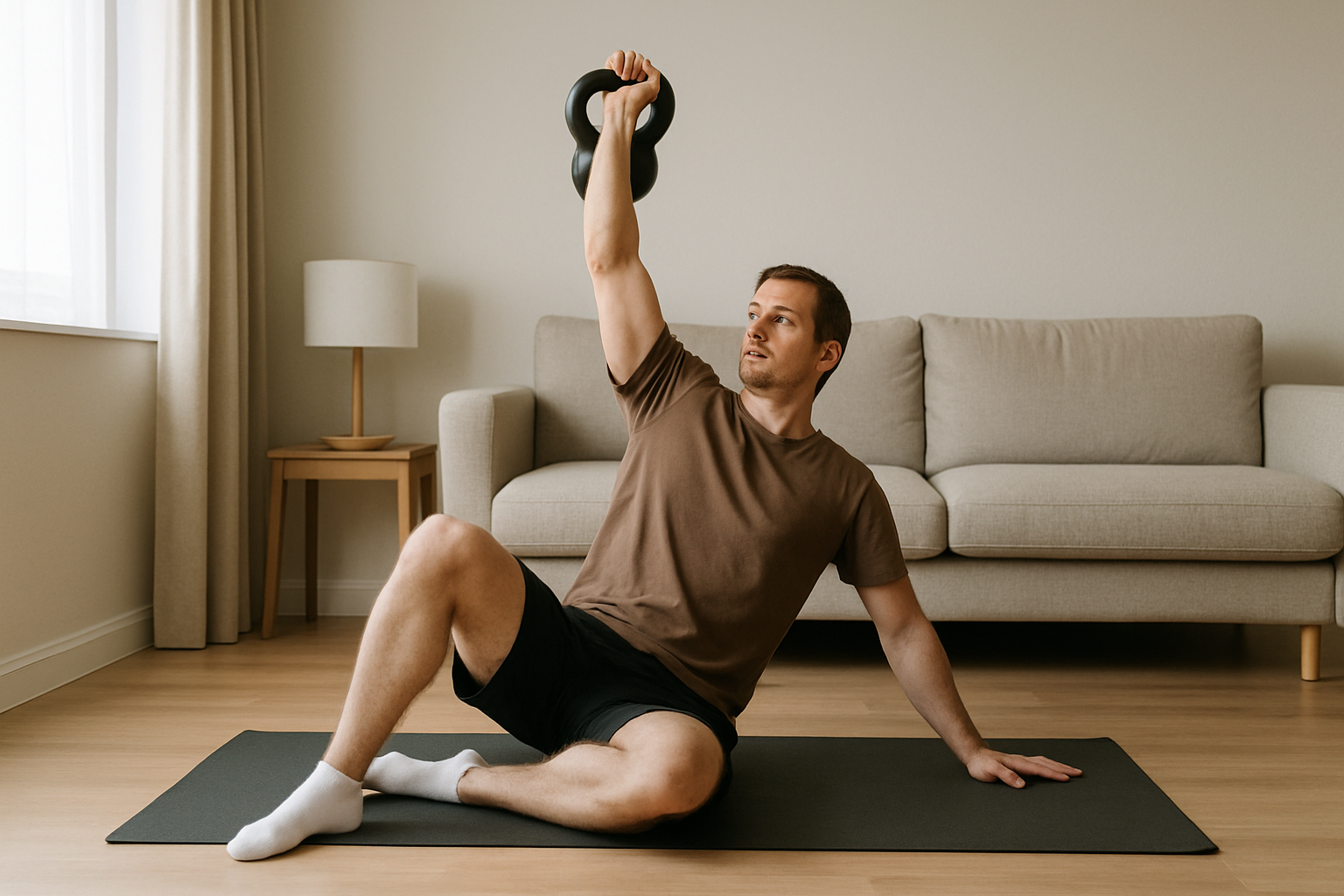6-Week Kettlebell Workout Plan (UK) for Beginners at Home
6-Week Kettlebell Workout Plan (UK) for Beginners at Home
Reading time: 11 minutes | Last updated: September 2025
New to kettlebells and want a structured kettlebell workout plan you can do at home? This guide shows UK beginners exactly what to do each week, which weight to start with, how to warm up safely, and how to progress without flaring up your back or wrists. You’ll get clear sessions, coaching cues, and simple nutrition tips to support strength, fat loss and fitness.
- Who it’s for: Beginners training at home with 1–2 kettlebells.
- What you’ll get: A 6-week progressive programme, technique cues, warm-up/cooldown, and recovery guidance.
- Quick start: Most beginners do well with a 8–12 kg kettlebell (women) or 12–16 kg (men) for swings and lower-body moves; use a lighter bell for presses and Turkish get-ups.
TL;DR
- Train 3 days per week (30–40 minutes). Focus on hip hinge, squat, press, row and carry.
- Start with 8–12 kg (women) or 12–16 kg (men) for swings; pick a lighter bell for overhead work.
- Use RPE 6–8 for work sets; breathe through the nose when possible and maintain tight midline.
- Progress each week by adding a set, a few reps, or a small weight jump—not all three.
- Expect better posture, stronger glutes and core, and improved conditioning in 4–6 weeks.
- Pair with brisk walking, running or rowing for cardio; see our treadmill 5k training plan for a simple endurance add-on.
Table of contents
- What kettlebells are and why they work
- Quick answers: weights, frequency, expected results
- Equipment and home setup (UK flats and houses)
- Warm-up and activation (5–8 minutes)
- Technique fundamentals: hinge, swing, squat, press and get-up
- Kettlebell workout plan: week-by-week programming
- Cooldown and mobility (5 minutes)
- Recovery, injury prevention and sleep
- Nutrition for strength, fat loss and recovery
- Scaling for time, space and equipment
- Alternatives and cross-training
- FAQs
- Glossary
What kettlebells are and why they work
A kettlebell is a compact cast-iron weight with an offset handle. That simple shape makes it perfect for dynamic movements like swings, cleans and snatches, engaging your posterior chain (glutes, hamstrings and back), improving core stability and grip strength. Research shows kettlebell training can elevate heart rate into vigorous zones and improve strength and power in a time-efficient way (PubMed, PubMed).
It also fits UK homes well: one bell, minimal space, and low noise compared with dropping barbells. The plan below blends strength work (goblet squats, presses, rows) with conditioning (swings, carries) for a balanced, full-body routine.
Quick answers: weights, frequency, expected results
- Which weight to start with? Common starting points: 8–12 kg for women, 12–16 kg for men for swings and lower-body moves; use 4–8 kg lighter for overhead work and Turkish get-ups. Always prioritise form.
- How often? 3 sessions per week is ideal for beginners (e.g., Mon–Wed–Fri). Short on time? Do 2 sessions and add a 10-minute swing finisher once per week.
- How soon will I see results? Most beginners notice better posture and stamina within 2–3 weeks; visible changes in 4–6 weeks with consistent training and nutrition, in line with UK health guidance to accumulate at least 150 minutes of moderate activity weekly (NHS; UK CMO).
- Is it safe for beginners? Yes—if you learn the hip hinge, keep neutral spine, and progress gradually. Stop if you feel sharp pain.

Equipment and home setup (UK flats and houses)
You only need one to two kettlebells, a non-slip mat and 2–3 m of clear floor space. Check ceiling height before overhead presses or get-ups. Protect floors with a rubber mat and train in breathable trainers or barefoot if your floor is stable and clean.
- Noise: Kettlebells are quiet if you control the eccentric and park the bell gently.
- Storage: Bells tuck into a corner; no bulky racks needed.
- Safety: Keep the area clear, especially around pets and children.
Building out your space? See our guide on how to build a home gym for floor, mat and storage ideas.
Warm-up and activation (5–8 minutes)
Do this before each session. Aim to raise heart rate, mobilise hips and shoulders, and activate glutes and core.
- 2 minutes easy cardio (march on the spot, stepper, or skipping)
- Hip circles x 6 per side; thoracic rotations x 6 per side
- Glute bridge x 10 with 2-second hold
- Half-kneeling hip flexor stretch x 20 seconds per side
- Bodyweight hinge patterning: wall taps or dowel hip hinges x 8
- Shoulder “around the world” with light band x 10

- Use nasal breathing in the warm-up to set a calm tempo.
- Practise the kettlebell deadlift before your first swing session.
- Film a set from the side to check neutral spine and hinge depth.
Technique fundamentals: hinge, swing, squat, press and get-up
Hinge and deadlift
- Feet shoulder-width, shins near vertical, weight mid-foot to heel.
- Push hips back, keep spine neutral, lats on (imagine squeezing oranges in your armpits).
- Stand tall by driving the floor away and squeezing glutes.
Hard-style swing
- Hike the bell back high in the groin; avoid it dropping below knees.
- Explosive hip snap; arms act as straps. Bell should float to chest height.
- Exhale short and sharp at hip extension; park the bell safely between sets.
Goblet squat
- Hold the bell horns at chest; elbows inside knees at the bottom.
- Keep heels down, chest proud, knees tracking over toes.
Press and row
- Neutral wrist; stack bell over forearm (don’t let it collapse your wrist).
- Brace, squeeze glutes, and press smoothly. Row with a flat back.
Turkish get-up (TGU)
- Move slowly, one stage at a time; eyes on the bell, wrist straight.
- Stop if shoulder feels unstable; use a shoe or light dumbbell at first.
- Squatting your swings (knees forward) instead of hinging.
- Overextending the lower back at the top of swings or presses.
- Letting the bell crash on the forearm in cleans and get-ups—learn a soft catch.

Kettlebell workout plan: week-by-week programming
Train three days per week (e.g., Mon–Wed–Fri). Use the Rate of Perceived Exertion (RPE) scale 1–10. Work at RPE 6–7 in Week 1, building to RPE 7–8 by Week 6. Rest 60–90 seconds between sets unless noted. Keep technique crisp—stop sets one rep before form breaks.
Week 1–2 (Foundation)
Session A
- Kettlebell deadlift: 4 x 6 @ RPE 6
- Goblet squat: 3 x 6–8
- Half-kneeling press (per arm): 3 x 6
- Farmer carry: 4 x 20–30 m (or 30–40 seconds)
Session B
- Hinge patterning + swing drill (hike + 3 swings + park) x 5 sets, rest as needed
- One-arm row (per arm): 3 x 8
- Glute bridge or hip thrust: 3 x 10
- Front rack carry: 3 x 20–30 m
Session C
- Swings: 10 x 10 on the minute (EMOM) with a light bell; stop if form degrades
- Goblet squat: 3 x 8
- Tall-kneeling halo: 3 x 8 each way (shoulder mobility)
Week 3–4 (Progressive overload)
Session A
- Swings: 12 x 10 EMOM or 8 x 15 every 75 seconds @ RPE 7
- Goblet squat: 4 x 8
- Standing press (per arm): 3 x 6–8
- Suitcase deadlift (single bell, per side): 3 x 8
Session B
- Clean to front rack (per arm): 4 x 5
- One-arm row (per arm): 4 x 8–10
- Reverse lunge (goblet): 3 x 8 per leg
- Farmer carry: 4 x 30–40 m
Session C
- Strength circuit x 3–4 rounds: 10 swings, 6 goblet squats, 6 presses (per arm), 8 rows (per arm); rest 90–120 seconds between rounds @ RPE 7–8
- Optional: TGU skill practice with light bell: 2 x 1 per side
Week 5–6 (Strong and conditioned)
Session A
- Power swings: 15 x 10 EMOM or 10 x 15 every 75 seconds
- Front squat (double bell if available; otherwise slow goblet): 4 x 6–8
- Press ladder (per arm): 1-2-3 reps x 3 ladders (rest between rungs)
- Mixed carry finisher: 3 rounds of 20 m farmer + 20 m rack + 20 m overhead (light)
Session B
- Clean and press (per arm): 5 x 3
- Row (per arm): 4 x 10 with 2-second pause at top
- Romanian deadlift: 3 x 10 slow eccentric
- Core: dead bug or plank: 3 x 30–45 seconds
Session C (Conditioning)
- 12-minute AMRAP: 12 swings, 8 goblet squats, 6 push presses (per arm). Keep quality high; pace for steady breathing.
- Optional TGU: 3 x 1 per side
Progression rules: Each week, increase total volume (sets or reps) slightly or nudge weight up if all sets felt like RPE ≤7. Only change one variable at a time. If form slips, step back for a week and focus on technique.

Heart rate and RPE guidance
- RPE 6–7: Working but can speak in short sentences (roughly 65–75% max heart rate).
- RPE 7–8: Breathing hard, 3–5 word sentences (75–85% MHR).
A basic wrist-based HR monitor is helpful but optional. Swings typically drive HR into moderate-to-vigorous zones, supporting the UK guideline to include vigorous activity weekly (UK CMO).
Cooldown and mobility (5 minutes)
- Walking or easy marches: 1 minute
- Child’s pose with side reach: 30 seconds per side
- Hip flexor stretch: 30 seconds per side
- Hamstring floss (supine banded): 30 seconds per side
- Chest opener on wall or doorway: 30 seconds per side
Recovery, injury prevention and sleep
- Sleep: Aim for 7–9 hours; consistent bedtime supports recovery and skill learning.
- Back care: Keep swings snappy with a neutral spine and strong brace. If your lower back pumps up, the bell may be too heavy or your hinge too deep.
- Shoulders: Keep the bell stacked over the forearm; build overhead volume slowly.
- Deload if needed: If you feel unusually fatigued, reduce sets by 25–30% for one week.
New to exercise or managing a condition? Speak to your GP or a qualified professional before starting. For general activity targets, see the NHS guidelines.
Nutrition for strength, fat loss and recovery
- Protein: 1.6–2.2 g per kg body mass daily (e.g., 96–132 g for a 60 kg person) to support muscle repair.
- Hydration: ~30–35 ml per kg daily; add 300–500 ml around training.
- Carbohydrate: Include a fist-sized portion pre-training for energy (oats, banana, wholegrain toast), especially on conditioning days.
- Creatine monohydrate: 3–5 g daily is well-supported for strength and power.
- Caffeine: 2–3 mg per kg 30–45 minutes pre-workout may boost performance if tolerated; avoid late evening.
Prioritise whole foods, fruits and vegetables, plus calcium and vitamin D per UK advice in winter months if intake or sun exposure is low (NHS).
Scaling for time, space and equipment
- Only 20 minutes? Do 5 rounds: 10 swings, 6 goblet squats, 6 presses (per arm), 8 rows (per arm); minimal rest.
- Low ceilings? Skip overhead presses; use push presses to chest height or floor presses.
- No heavy bell? Slow eccentrics (3–4 seconds down), pauses at bottom, and more reps build stimulus safely.
- Wrist comfort: Use a sweatband or wrist guard; keep the bell close in the rack position to avoid slamming.
Alternatives and cross-training
Kettlebells are versatile, but mixing in steady-state or interval cardio improves heart health and recovery. Try 2 short cardio sessions weekly: 20–30 minutes brisk walking or cycling, or low-impact cross-trainer intervals. Rower fans can explore our curated picks in best rowing machines and the in-depth BodyMax Oxbridge HR Air Rowing Machine review. Prefer elliptical or bike cross-training? See our JLL CT100 review. Runners can dovetail this plan with our treadmill 5k training plan.
Kettlebell vs dumbbell vs resistance band:
- Kettlebell: Best for dynamic hip hinge and full-body power; great grip and core demand.
- Dumbbell: Excellent for isolated strength and bilateral control; easier overhead progressions.
- Bands: Travel-friendly, joint-friendly variable resistance; limited max load.

FAQs
What weight kettlebell should I buy first?
Common starting points: 8–12 kg for women, 12–16 kg for men for swings and squats; 4–8 kg lighter for presses and get-ups. Choose the lightest weight that lets you keep a neutral spine and crisp hip snap.
Is a kettlebell workout enough for fat loss?
Yes—if combined with a modest calorie deficit and consistent training. Swings and circuits elevate heart rate, while strength work preserves lean mass. Aim to meet UK activity guidelines weekly (NHS/UK CMO).
Are kettlebell swings bad for your back?
Not if done with a hinge, neutral spine and appropriate load. Start with deadlifts and hike drills. If pain persists, stop and seek professional advice.
How many days per week should beginners train?
Three days with a rest day between works well. Two days can still progress if you’re consistent and manage volume.
Can I combine this with running or rowing?
Yes. Add 2 x 20–30 minute easy runs or rows, or intervals on non-lifting days. For structured options, see our treadmill 5k training plan and best rowing machines.
What if I only have a light kettlebell?
Increase time under tension (slow lowers, pauses), use single-leg variations, and add reps or sets. Progress to a heavier bell when sets feel like RPE ≤6.
How do I avoid the bell banging my forearm?
Keep the bell close and rotate around the handle into rack position (like zipping a jacket), not flipping it over. Practise with a light bell first.
Glossary
- RPE: Rate of Perceived Exertion (effort scale 1–10).
- EMOM: Every Minute on the Minute—start a set each minute.
- AMRAP: As Many Rounds As Possible in a set time.
- Turkish get-up (TGU): A ground-to-stand movement under load, building shoulder stability and total-body control.
Related reading
- build a home gym
- best rowing machines
- BodyMax Oxbridge HR Air Rowing Machine review
- JLL CT100 review
- treadmill 5k training plan
Disclaimer: This article is for general information and is not a substitute for medical advice. If you have health conditions, are pregnant, or are new to exercise, consult your GP or a qualified professional before starting. Progress gradually, prioritise form, and stop if you experience pain.
Conclusion and next steps
With one bell, limited space and 30–40 minutes, you can build strength, conditioning and confidence in six weeks. Keep technique tight, progress one variable at a time, and pair your sessions with simple nutrition and good sleep.
Ready to round out your cardio? Compare options in our best rowing machines guide or build your training space with our build a home gym tips.